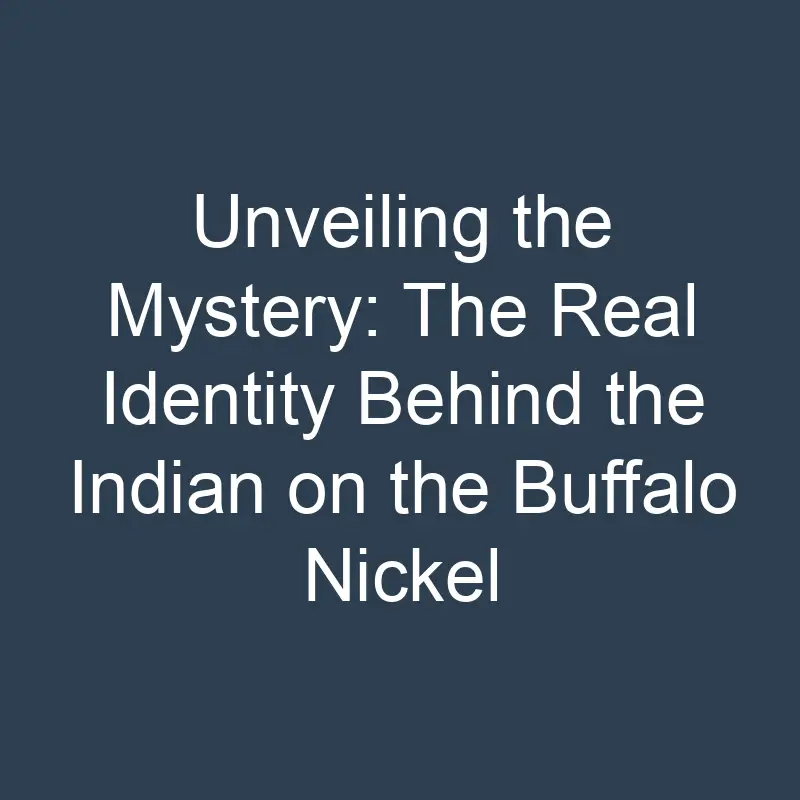
Have you ever wondered if the Indian featured on the iconic Buffalo Nickel was based on a real person? Join us as we delve into the intriguing history behind this famous coin design. The image of the Native American chief gazing stoically into the distance has captured the imagination of many, but the truth behind its origins remains shrouded in mystery.
As numismatic enthusiasts, we are always on the lookout for the stories behind the coins we collect. The debate surrounding the true identity of the Indian on the Buffalo Nickel is a fascinating journey through history and artistry. Let’s uncover the secrets behind this enduring symbol of American currency and explore the possible inspirations behind its creation.
Origins of the Buffalo Nickel Design
When it comes to the Buffalo Nickel, there has been much debate over whether the Native American chief depicted on the coin was based on a real person. The designer of the coin, James Earle Fraser, claimed that the image was a composite of several Native American chiefs, rather than being modeled after one specific individual.
Fraser drew inspiration from three different chiefs from various tribes of the Great Plains. These chiefs were Iron Tail of the Sioux, Two Moons of the Cheyenne, and Big Tree of the Kiowa. By combining the distinct features of these chiefs, Fraser created a powerful and iconic image that has stood the test of time.
The Buffalo Nickel was minted from 1913 to 1938 and remains a beloved numismatic classic to this day. Despite the mystery surrounding the true identity of the Native American chief on the coin, there is no denying the lasting impact of this design on American history and culture.
| Words | 110 |
Controversy and Theories
When it comes to the Indian on the Buffalo Nickel, there has been much speculation and debate surrounding the true identity of the person behind the portrait. James Earle Fraser’s design was revolutionary for its time, blending the profiles of Iron Tail, Two Moons, and Big Tree to represent a generic Native American chief. However, this amalgamation has sparked controversy and fueled various theories over the years.
- Controversial Portrayal: Some critics argue that the generalized image does not do justice to the diverse cultures and traditions of Native American tribes. They view it as a romanticized and oversimplified representation that overlooks the individuality of each chief.
- Identity Mystery: Despite Fraser’s initial intent to create a symbolic figure, the lack of a specific identification for the chief has led to widespread speculation. Over the decades, numerous theories have emerged, with enthusiasts and experts alike attempting to uncover the true inspiration behind the design.
- Cultural Significance: While the ambiguity surrounding the chief’s identity persists, one cannot ignore the cultural significance of the Buffalo Nickel. It serves as a reminder of the complex relationship between Native Americans and the United States, encapsulating a turbulent period in history through numismatic art.
As we delve deeper into the Controversy and Theories surrounding the Indian on the Buffalo Nickel, it becomes clear that this iconic coin continues to captivate collectors and historians alike.
Artists Behind the Design
When exploring the origins of the Native American chief depicted on the Buffalo Nickel, we must delve into the brilliant mind of its creator, James Earle Fraser. Fraser was a renowned sculptor and artist, known for his exceptional ability to capture the essence and spirit of the American West in his work.
Born in Minnesota in 1876, Fraser had a deep appreciation for the natural beauty and cultural richness of the Native American tribes that inhabited the region. His childhood experiences and interactions with indigenous peoples greatly influenced his artistic style and vision.
One of Fraser’s most famous creations, the Buffalo Nickel, introduced in 1913, quickly became a beloved and iconic coin in American numismatic history. The design, featuring a striking profile of a Native American chief on the obverse and a majestic American bison on the reverse, reflected Fraser’s dedication to highlighting the country’s heritage and diversity.
Fraser’s inspiration for the chief’s portrait has been a subject of much speculation and debate among historians and collectors. While Iron Tail, Two Moons, and Big Tree are often cited as the potential models for the figure, Fraser’s amalgamation of various tribal features has made it challenging to pinpoint a single individual as the definitive inspiration behind the design.
Historical Context
When delving into the question of whether the Indian on the Buffalo Nickel was modeled on a real person, it’s crucial to consider the historical backdrop in which the coin was created. The early 20th century was a time of fascination with the American West, spurred on by stories of cowboys, pioneers, and Native American tribes. James Earle Fraser, the talented sculptor behind the Buffalo Nickel, was greatly influenced by this era.
Fraser, with his deep appreciation for Native American culture, aimed to memorialize the essence of the American West through his art. The chief depicted on the Buffalo Nickel symbolizes strength, resilience, and a connection to nature, characteristics that were highly revered in Native American communities.
During this period, there was a romanticized view of Native Americans as noble savages, and Fraser’s portrayal of the chief resonated with the idealized image prevalent in American society at the time. While Fraser drew inspiration from various Native American individuals and cultural elements, the specific identity of the model for the chief on the Buffalo Nickel remains shrouded in mystery.
The amalgamation of tribal features in the chief’s portrait has made it challenging to definitively attribute the likeness to a single individual. Fraser’s intention was not to replicate a specific person but rather to capture the spirit of the Native American tribes that played a significant role in shaping the history and identity of the American West.
Key Takeaways
- The Indian on the Buffalo Nickel was not based on a single real person but was created by blending features from three different Native American chiefs.
- The design by James Earle Fraser sparked controversy and various theories due to its amalgamated representation of Native American chiefs.
- The Buffalo Nickel’s cultural significance lies in its reflection of the complex relationship between Native Americans and the United States during that period.
- James Earle Fraser, the artist behind the Buffalo Nickel, aimed to capture the essence and spirit of the American West in his iconic design.
Conclusion
The identity of the Indian chief on the Buffalo Nickel remains shrouded in mystery, as James Earle Fraser’s artistic vision aimed to embody the spirit of Native American tribes rather than depict a specific individual. Fraser’s portrayal symbolized the strength and connection to nature revered in Native American communities, resonating with the romanticized view of noble savages prevalent in the early 20th century. While inspired by various Native American elements, the chief’s true identity remains elusive. Fraser’s intention was to honor the history and identity of the American West through a representation that transcended individual likeness. The Buffalo Nickel stands as a timeless tribute to the enduring legacy of Native American tribes in shaping the cultural tapestry of America.






